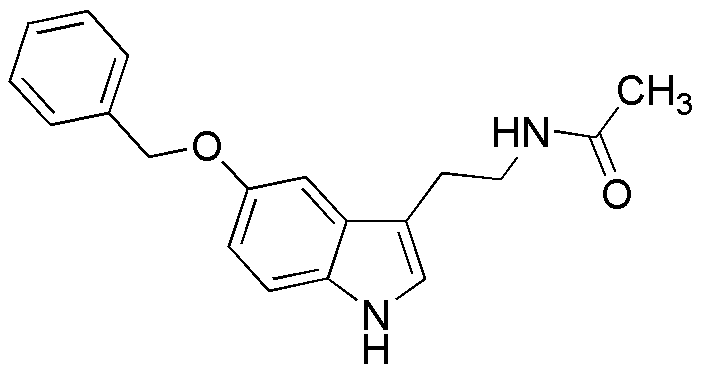N-Acetyl-5-benzyloxytryptamine is widely utilized in research focused on:
- Neuroscience Research: This compound is studied for its potential effects on serotonin receptors, making it valuable in understanding mood disorders and developing antidepressants.
- Pharmaceutical Development: It serves as a lead compound for synthesizing new drugs aimed at treating sleep disorders, thanks to its structural similarity to melatonin.
- Biochemical Studies: Researchers use it to investigate the biochemical pathways of tryptamines, helping to elucidate their roles in various physiological processes.
- Natural Product Synthesis: The compound is employed in the synthesis of other complex organic molecules, benefiting industries focused on creating novel therapeutic agents.
- Drug Formulation: Its properties allow it to be incorporated into formulations aimed at enhancing bioavailability and efficacy of active pharmaceutical ingredients.
General Information
Properties
Safety and Regulations
Applications
N-Acetyl-5-benzyloxytryptamine is widely utilized in research focused on:
- Neuroscience Research: This compound is studied for its potential effects on serotonin receptors, making it valuable in understanding mood disorders and developing antidepressants.
- Pharmaceutical Development: It serves as a lead compound for synthesizing new drugs aimed at treating sleep disorders, thanks to its structural similarity to melatonin.
- Biochemical Studies: Researchers use it to investigate the biochemical pathways of tryptamines, helping to elucidate their roles in various physiological processes.
- Natural Product Synthesis: The compound is employed in the synthesis of other complex organic molecules, benefiting industries focused on creating novel therapeutic agents.
- Drug Formulation: Its properties allow it to be incorporated into formulations aimed at enhancing bioavailability and efficacy of active pharmaceutical ingredients.
Documents
Safety Data Sheets (SDS)
The SDS provides comprehensive safety information on handling, storage, and disposal of the product.
Product Specification (PS)
The PS provides a comprehensive breakdown of the product’s properties, including chemical composition, physical state, purity, and storage requirements. It also details acceptable quality ranges and the product's intended applications.
Certificates of Analysis (COA)
Search for Certificates of Analysis (COA) by entering the products Lot Number. Lot and Batch Numbers can be found on a product’s label following the words ‘Lot’ or ‘Batch’.
*Catalog Number
*Lot Number
Certificates Of Origin (COO)
This COO confirms the country where the product was manufactured, and also details the materials and components used in it and whether it is derived from natural, synthetic, or other specific sources. This certificate may be required for customs, trade, and regulatory compliance.
*Catalog Number
*Lot Number
Safety Data Sheets (SDS)
The SDS provides comprehensive safety information on handling, storage, and disposal of the product.
DownloadProduct Specification (PS)
The PS provides a comprehensive breakdown of the product’s properties, including chemical composition, physical state, purity, and storage requirements. It also details acceptable quality ranges and the product's intended applications.
DownloadCertificates of Analysis (COA)
Search for Certificates of Analysis (COA) by entering the products Lot Number. Lot and Batch Numbers can be found on a product’s label following the words ‘Lot’ or ‘Batch’.
*Catalog Number
*Lot Number
Certificates Of Origin (COO)
This COO confirms the country where the product was manufactured, and also details the materials and components used in it and whether it is derived from natural, synthetic, or other specific sources. This certificate may be required for customs, trade, and regulatory compliance.


